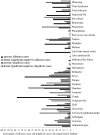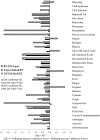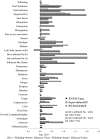Influenza detection from emergency department reports using natural language processing and Bayesian network classifiers
- PMID: 24406261
- PMCID: PMC4147621
- DOI: 10.1136/amiajnl-2013-001934
Influenza detection from emergency department reports using natural language processing and Bayesian network classifiers
Erratum in
-
Correction.J Am Med Inform Assoc. 2023 Dec 22;31(1):281. doi: 10.1093/jamia/ocad155. J Am Med Inform Assoc. 2023. PMID: 37757460 Free PMC article. No abstract available.
Abstract
Objectives: To evaluate factors affecting performance of influenza detection, including accuracy of natural language processing (NLP), discriminative ability of Bayesian network (BN) classifiers, and feature selection.
Methods: We derived a testing dataset of 124 influenza patients and 87 non-influenza (shigellosis) patients. To assess NLP finding-extraction performance, we measured the overall accuracy, recall, and precision of Topaz and MedLEE parsers for 31 influenza-related findings against a reference standard established by three physician reviewers. To elucidate the relative contribution of NLP and BN classifier to classification performance, we compared the discriminative ability of nine combinations of finding-extraction methods (expert, Topaz, and MedLEE) and classifiers (one human-parameterized BN and two machine-parameterized BNs). To assess the effects of feature selection, we conducted secondary analyses of discriminative ability using the most influential findings defined by their likelihood ratios.
Results: The overall accuracy of Topaz was significantly better than MedLEE (with post-processing) (0.78 vs 0.71, p<0.0001). Classifiers using human-annotated findings were superior to classifiers using Topaz/MedLEE-extracted findings (average area under the receiver operating characteristic (AUROC): 0.75 vs 0.68, p=0.0113), and machine-parameterized classifiers were superior to the human-parameterized classifier (average AUROC: 0.73 vs 0.66, p=0.0059). The classifiers using the 17 'most influential' findings were more accurate than classifiers using all 31 subject-matter expert-identified findings (average AUROC: 0.76>0.70, p<0.05).
Conclusions: Using a three-component evaluation method we demonstrated how one could elucidate the relative contributions of components under an integrated framework. To improve classification performance, this study encourages researchers to improve NLP accuracy, use a machine-parameterized classifier, and apply feature selection methods.
Published by the BMJ Publishing Group Limited. For permission to use (where not already granted under a licence) please go to http://group.bmj.com/group/rights-licensing/permissions.
Figures




References
-
- Chu D. Clinical feature extraction from emergency department reports for biosurveillance [master's thesis]. Pittsburgh, University of Pittsburgh, 2007
Publication types
MeSH terms
Grants and funding
LinkOut - more resources
Full Text Sources
Other Literature Sources
Medical

